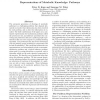Free Online Productivity Tools
i2Speak
i2Symbol
i2OCR
iTex2Img
iWeb2Print
iWeb2Shot
i2Type
iPdf2Split
iPdf2Merge
i2Bopomofo
i2Arabic
i2Style
i2Image
i2PDF
iLatex2Rtf
Sci2ools
120
Voted
ISMB
1994
1994
Representations of Metabolic Knowledge: Pathways
The automatic generation of drawings of metabolic pathways is a challenging problem that depends intimately on exactly what information has been recorded for each pathway, and on how that information is encoded. The chief contributions of the paper are a minimized representation for biochemical pathways called the predecessor list, and inference procedures for converting the predecessor list into a pathway-graph representation that can serve as input to a pathway-drawing algorithm. The predecessor list has several advantages over the pathway graph, including its compactness and its lack of redundancy. The conversion between the two representations can be formulated as both a constraintsatisfaction problem and a logical inference problem, whose goal is to assign directions to reactions, and to determine which are the main chemical compounds in the reaction. We describe a set of production rules that solves this inference problem. We also present heuristics for inferring whether the ext...
Related Content
| Added | 02 Nov 2010 |
| Updated | 02 Nov 2010 |
| Type | Conference |
| Year | 1994 |
| Where | ISMB |
| Authors | Peter D. Karp, Suzanne M. Paley |
Comments (0)

